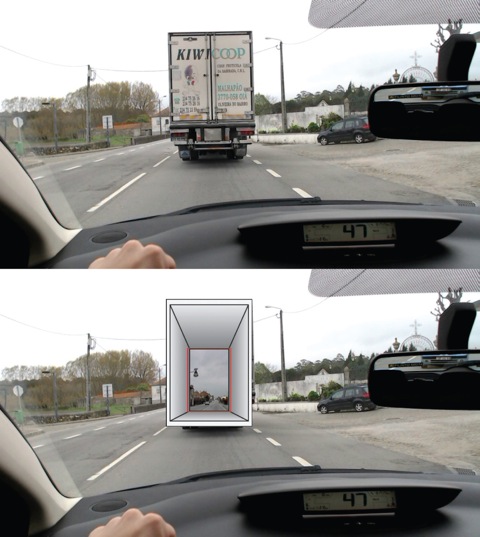This Clever Augmented Reality System Lets Drivers See Through Cars
One day, augmented reality may help drivers know when to pass up a slow truck on a two-lane road
Credit: Michel Ferreira
It is hard to imagine, but there was once a time when cars didn’t come equipped with rearview mirrors. In fact, it wasn’t until 1916 that the simple, yet game-changing invention became standard, making it easy for drivers to safely weave through traffic—except, of course, in those situations when they’re stuck behind a slow moving cargo truck on a two-lane road. Too bad there wasn’t also a way to see ahead of these road turtles to determine when it would be safe to pass.
Today, it’s 100 percent possible, and to prove it, researcher Michel Ferreira of the University of Porto in Portugal has developed a technology that seems to magically let you peer through the car you’re trailing. And, for manufacturers, what’s attractive about the computer scientist’s “See-Through System” is that it isn’t an entirely new device but rather a clever adaptation of a nascent technology known as Vehicular Communication Systems, designed to let wirelessly interconnected cars communicate and update each other with traffic information. One example of such systems is the ongoing development of semi-autonomous platooning vehicles, where a network of cars relay information, which is used to navigate the streets together as a convoy.
The See-Through System makes innovative use of these systems by tapping into the visual data being recorded by the forward-facing webcam that some vehicles have installed on their windshield. When a truck or bus ahead of you has this type of webcam, the system within your own car streams the feed from this camera into a transparent LCD screen built into your windshield. The viewpoint helps you judge distances and see whether any incoming cars in the other lane are moving into view.
“These windshield cameras will someday be very common and I predict you’ll eventually find them standard on every car,” Ferreira says. “But besides letting cars simply communicate with each other, it can also be deployed as a form of augmented reality, where you can see through cars.”
The most immediate and obvious concern with relying on transmitted data from some of these more elaborate communication systems, like for instance GPS, is the possibility of computer error and the real-time lag that’s common even with high-speed data transmission technologies. The reason why rearview mirrors are generally dependable is because they reflect accurate and instant changing road conditions at the speed of light. Even then car manufacturers are required to affix a warning that “objects may appear closer than they actually are.” In an interview with New Scientist, Hannes Kaufmann of the Vienna University of Technology in Austria says that while he thinks “it’s a good idea to support drivers to judge situations better,” these kind of interventions can be a “two-edged sword.”
“What if the image transmission stutters?” he wonders.
Ferreira has already taken this potential “blind spot” into account and has thoroughly road-tested the system (as evidenced in the video), even going to so far as building in a fail-safe that shuts off the feed in case a glitch were to occur.
“The big problem that’s been brought up is the latency of the transmission. When you’re driving you don’t want to have a half-second delay, and our tests show that the latency isn’t more than 200 milliseconds, which translates to about 10 meters at high speed and won’t make any difference with safety in real-world driving,” Ferreira argues.
Even if you’re not quite ready to trust the professor’s word on it, there’s no need to worry right this minute. Such a system likely won’t be available until car-to-car communication becomes much more ubiquitous.
“What you’re seeing in the video are the raw beginnings of core research,” he says. “This has been possible for a little while now, so the work I’m doing is just so that people can see that it is.”
/https://tf-cmsv2-smithsonianmag-media.s3.amazonaws.com/accounts/headshot/tuan-nguyen.jpg)



/https://tf-cmsv2-smithsonianmag-media.s3.amazonaws.com/accounts/headshot/tuan-nguyen.jpg)